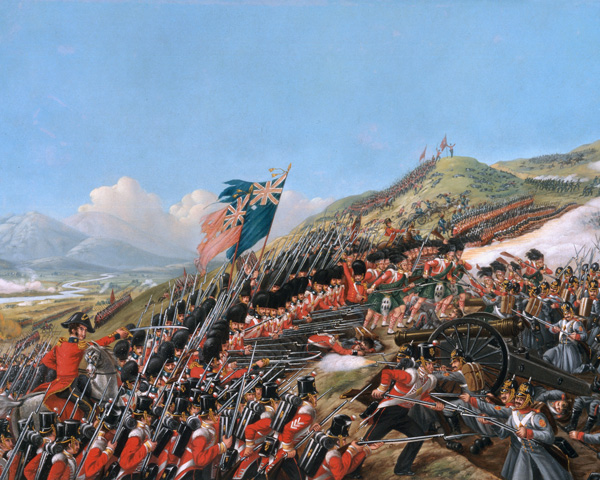Origins
The origins of this regiment go back to a unit raised for King William III by George Saunderson, 5th Viscount Castleton, in 1689. During the Nine Years War (1688-97), it fought for William in Flanders, including at the Siege of Namur (1695).
In 1694, its colonelcy was transferred to Thomas Saunderson, a relative of Castleton. Four years later, after the war had ended, Saunderson's unit was disbanded. However, he raised a new regiment in 1702, this time as marines.
Iberia
The new unit fought in Iberia during the War of the Spanish Succession (1702-13) and was involved in the capture and defence of Gibraltar (1704-05), and the battles of Malaga (1704), Barcelona (1705) and Alicante (1706). It then moved to the islands of Sardinia (1708) and Minorca (1708).
In 1708, it moved to Scotland to defend the Firth of Forth for seven years. In 1715, it converted into a regular line infantry regiment and began three years garrisoning Ireland.
From 1718 to 1728, the regiment was back in Minorca and Gibraltar, where it took part in the Anglo-Spanish War (1727-29). At the end of that period, it returned to Ireland, this time for 16 years.
Mid-18th century
During the War of the Austrian Succession (1740-48), it took part in raids on the French coast (1746-47) and served as marines on board ship at the First Battle of Cape Finisterre (1747) before returning to the British Isles until 1755. During this period, in 1751, it was given the number 30 in the order of precedence.
During the Seven Years War (1756-63), the 30th took part in the raids on Rochefort (1757), St Malo (1758) and Belleisle (1761) before moving to Gibraltar in 1763.
The regiment garrisoned Ireland during the early years of the American War of Independence (1775-83), but arrived in South Carolina in 1781, going on to fight in the campaign in the southern colonies.
The following year, it became the county regiment of Cambridgeshire and moved to the West Indies, where it fought at St Croix and Antigua (1782), St Lucia (1783) and Dominica (1788-91).
Revolutionary and Napoleonic wars
The regiment spent most of the French Revolutionary Wars (1793-1802) back in the Mediterranean. It fought at Toulon (1793), on Corsica (1794) and Minorca (1798), before moving to Italy and Malta in 1799. The 30th then joined the British force in Egypt in 1801, going on to fight at Alexandria.
It returned to Britain in 1802 and a year later formed a 2nd Battalion. This served in the Peninsular War (1808-14) from 1809, fighting at Fuentes de Onoro (1811), Badajoz (1812) and Salamanca (1812), where it captured a French eagle.
It had suffered such losses by December 1812 that its six weakest companies had to return to Britain to recruit. The four strongest ones merged with a battalion of the 44th Regiment to form the 4th Provisional Battalion. This dissolved in 1813 and the four companies from 2nd Battalion re-joined six newly-recruited companies in Jersey later that year.
The battalion then returned to the Continent in 1814 and fought at Waterloo (1815), at one point forming square and resisting 11 French charges. In 1817, it was disbanded.
In the meantime, 1st Battalion sent five companies to fight in Hanover and northern Germany in 1805, before regrouping the following year to travel to India. It stayed there for over 20 years, sending detachments to Java and Portuguese Macao in 1807-08. It also fought in the Third Maratha War (1817-19).
Victorian era
For the next 35 years, the regiment alternated between overseas postings, including Bermuda, Nova Scotia and the Ionian Islands, and time in Britain and Ireland. The regiment also deployed to the Crimean War (1854-56), serving at the Alma (1854), Inkerman (1854) and Sevastopol (1855).
It was in Canada from 1861 to 1869. During this period, it defended the border with the United States during the Trent Affair (1861) and the Fenian Raids (1866).
Legacy
The regiment was on home service from 1869 to 1880, before returning to India, where in 1881 it merged with the 59th (2nd Nottinghamshire) Regiment of Foot to form The East Lancashire Regiment.
Regimental museums
The National Army Museum works with a network of Regimental and Corps Museums across the UK to help preserve and share the history and traditions of the Army and its soldiers.
Discover more about the 30th (Cambridgeshire) Regiment of Foot by visiting the Lancashire Infantry Museum in Preston.








!['The Battle of Inkermann Novr. 5th. 1854. The Gallant attack of Lieut.[sic] General Sir Geo. Cathcart who was killed with several officers in the engagement'](/sites/default/files/2020-04/97920_full.jpg)





